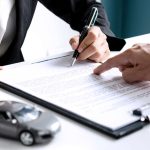The driver abandons the scene of an accident without delivering essential information to other affected persons. When such accidents occur, they leave behind both confusion and frustration for all involved parties. A defensive plan structure following a hit-and-run situation enables victims to handle the situation effectively and generate correct insurance claims.
Examine the accident scene in a composed manner.
Staying peaceful should be your first step whenever someone hits and flees. Being afraid will affect how you think clearly, making you less responsive when you need to act. First, check that you and all your passengers are unharmed, then identify the accident’s conditions. Call medical emergency personnel right away because someone has been injured. If there are no obvious injuries, get an immediate medical evaluation to check for internal damage.
Call the Police
Accidents that go without police reporting became notable as hit-and-runs. A police report is needed to process insurance claims and boost the chances of finding the at-fault driver. When possible, describe the hit-and-run vehicle by its brand, design, paintwork, and license plate number. The law enforcement team typically obtains video recordings from close security cameras.
Document the Scene
After hazardous conditions clear, take pictures of everything, including vehicle damage, the scene location, and possible tire marks that help prove responsibility. Note down all the details you remember about the crash, no matter how simple they are.
Gather Witness Information
Get contact details from anybody who saw the hit-and-run take place. Witness statements supply you with important facts you may have missed, such as the driving route of the other vehicle and its license plate details. Your insurance claim can be strengthened with witness statements, and they can assist police in finding the driver who created this accident.
Notify Your Insurance Provider About the Incident
After obtaining all data, contact your insurance provider about the hit-and-run incident. Most insurance plans have special situations, including hit-and-runs and their claims requiring you to notify your insurance provider immediately. Share the police documentation and evidence, including photographic proof and witness reports you compiled. Your insurance provider helps you with all claim procedures and then offers guidance on further actions.
Understanding Your Coverage
Your insurance needs evaluation to identify what it covers when a hit-and-run incident happens. Your motor insurance policy’s optional coverages (uninsured and underinsured motorists) will help pay for damage expenses from the accident. The absence of required insurance coverages puts you at risk of personal cost responsibility. Consult your insurance agent to learn which parts of your insurance policy will protect you from a hit-and-run incident.
Uninsured Motorist Coverage
UM coverage safeguards you if someone hits your vehicle in a hit-and-run situation or when you face an uninsured driver. The policy coverage provides financial help for medical care, pays for missed work, and fixes property broken because of the incident. Though states do not mandate UM coverage everywhere, you must get it due to its essential role in hit-and-run accidents.
Your Insurance Company Needs to Know about the Incident
After the accident you must send your gathered information to your insurance provider for evaluation. Your insurance provider will examine all vehicle damage before deciding to help pay for it. Include all evidence like the police report copy, witness accounts and pictures showing the vehicle damage during your insurance claim discussion. After receiving all the necessary details, the claims adjuster will decide on the next steps.
The Claims Investigation Process
After you submit your claim the insurance company starts reviewing the facts of the case. The insurance company will investigate through witness interviews, a police report assessment and your evidence review. The insurer will try to identify the other driver through available information. They aim to establish who is at fault and what money you need to recover.
The Role of Your Deductible
Your deductible plays an important role in the claims process. Your insurance must pay your deductible when you have no identified hit-and-run driver and depend solely on your coverage. The insurance company will cover your claim after you pay the fixed dollar amount of your deductible. Due to your high deductible, you should closely plan your budget before initiating the claim process.
Potential Legal Action Against the Responsible Driver
When authorities locate the driver who ran away from an accident, they must face justice for their illegal behaviour. If the responsible driver is found, the insurance firm will take legal action to recover their expenses.
Exploring Personal Injury Protection (PIP)
Personal accident insurance, called PIP, acts as a financial safety net in hit-and-run incidents. PIP pays your medical expenses and wage loss even though determining the at-fault party does not matter. Countries need to enable this optional insurance protection but certain states make it mandatory for drivers. PIP insurance from your policy helps pay your medical expenses if you cannot trace the hit-and-run driver.
Dealing with Emotional Trauma
After suffering from a hit-and-run accident, both your body and mind require proper treatment. A hit-and-run crash makes you feel distressed and worried. When emotional trauma from a traffic accident makes you feel unhealthy, always reach out to professionals. You can speak with a counselling professional and find that insurance may assist with therapy expenses related to this event.
Working with an Attorney
When dealing with insurance company issues that impact your rights or when claims become difficult, contact an attorney for help. A personal injury lawyer defends your rights and works with insurers while taking legal steps if necessary. A lawyer will benefit you when you receive news about the hit-and-run driver and claim damages later.
Preventing Future Hit-and-Run Incidents
Taking Support can decrease your chances of getting involved in a hit-and-run situation, but you cannot control external road behaviour. Stay in brightly lit parking spots, keeping your eyes on your environment. Do not leave valuable items in your vehicle because this may provoke criminal actions. Basic safety measures will make you less likely to become a hit-and-run target.
The Importance of Keeping Insurance Information Updated
Updating your insurance information regularly protects you from problems after a hit-and-run incident. Verify that all your data, including car details and insurance protection amount, are correct in the records. To maintain proper coverage, tell your insurance provider about any changes you make with your vehicle or residence. An up-to-date insurance policy will provide adequate protection if you get into an accident.
Conclusion
Being a hit-and-run victim causes extreme stress, but proper response steps reduce the impact. Keeping yourself composed while at the scene and contacting your insurance provider about the incident will create a smooth process for claim settlement. The best way to handle a hit-and-run is to know your insurance choices and seek assistance from industry experts when recovering your expenses.







